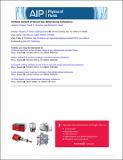Files in this item
Vortical control of forced two-dimensional turbulence
Item metadata
| dc.contributor.author | Fontane, Jerome Jacob Louis | |
| dc.contributor.author | Dritschel, David Gerard | |
| dc.contributor.author | Scott, Richard Kirkness | |
| dc.date.accessioned | 2014-08-25T23:01:33Z | |
| dc.date.available | 2014-08-25T23:01:33Z | |
| dc.date.issued | 2013-01-14 | |
| dc.identifier | 93444500 | |
| dc.identifier | ccb8d4a8-0c81-4599-8969-3d1294da867a | |
| dc.identifier | 84873438755 | |
| dc.identifier.citation | Fontane , J J L , Dritschel , D G & Scott , R K 2013 , ' Vortical control of forced two-dimensional turbulence ' , Physics of Fluids , vol. 25 , no. 1 , 015101 . https://doi.org/10.1063/1.4774336 | en |
| dc.identifier.issn | 1070-6631 | |
| dc.identifier.other | ORCID: /0000-0001-5624-5128/work/55378711 | |
| dc.identifier.other | ORCID: /0000-0001-6489-3395/work/64697779 | |
| dc.identifier.uri | https://hdl.handle.net/10023/5236 | |
| dc.description | Jérôme Fontane is supported by the European Community in the framework of the CONVECT project under Grant No. PIEF-GA-2008-221003. | en |
| dc.description.abstract | A new numerical technique for the simulation of forced two-dimensional turbulence[D. Dritschel and J. Fontane, “The combined Lagrangian advection method,” J. Comput. Phys.229, 5408–5417 (Year: 2010)10.1016/j.jcp.2010.03.048] is used to examine the validity of Kraichnan-Batchelor scaling laws at higher Reynolds number than previously accessible with classical pseudo-spectral methods, making use of large simulation ensembles to allow a detailed consideration of the inverse cascade in a quasi-steady state. Our results support the recent finding of Scott [R. Scott, “Nonrobustness of the two-dimensional turbulent inverse cascade,” Phys. Rev. E75, 046301 (Year: 2007)10.1103/PhysRevE.75.046301], namely that when a direct enstrophy cascading range is well-represented numerically, a steeper energy spectrum proportional to k−2 is obtained in place of the classical k −5/3 prediction. It is further shown that this steep spectrum is associated with a faster growth of energy at large scales, scaling like t −1 rather than Kraichnan's prediction of t −3/2. The deviation from Kraichnan's theory is related to the emergence of a population of vortices that dominate the distribution of energy across scales, and whose number density and vorticity distribution with respect to vortex area are related to the shape of the enstrophy spectrum. An analytical model is proposed which closely matches the numerical spectra between the large scales and the forcing scale. | |
| dc.format.extent | 12 | |
| dc.format.extent | 921975 | |
| dc.language.iso | eng | |
| dc.relation.ispartof | Physics of Fluids | en |
| dc.rights | © 2013 American Institute of Physics | en |
| dc.subject | Two-dimensional turbulence | en |
| dc.subject | QC Physics | en |
| dc.subject.lcc | QC | en |
| dc.title | Vortical control of forced two-dimensional turbulence | en |
| dc.type | Journal article | en |
| dc.contributor.sponsor | European Commission | en |
| dc.contributor.institution | University of St Andrews.Applied Mathematics | en |
| dc.contributor.institution | University of St Andrews.Marine Alliance for Science & Technology Scotland | en |
| dc.contributor.institution | University of St Andrews.Scottish Oceans Institute | en |
| dc.identifier.doi | 10.1063/1.4774336 | |
| dc.description.status | Peer reviewed | en |
| dc.identifier.url | http://dx.doi.org/10.1063/1.4774336 | en |
| dc.identifier.grantnumber | PIEF-GA-2008-221003 | en |
This item appears in the following Collection(s)
Items in the St Andrews Research Repository are protected by copyright, with all rights reserved, unless otherwise indicated.

